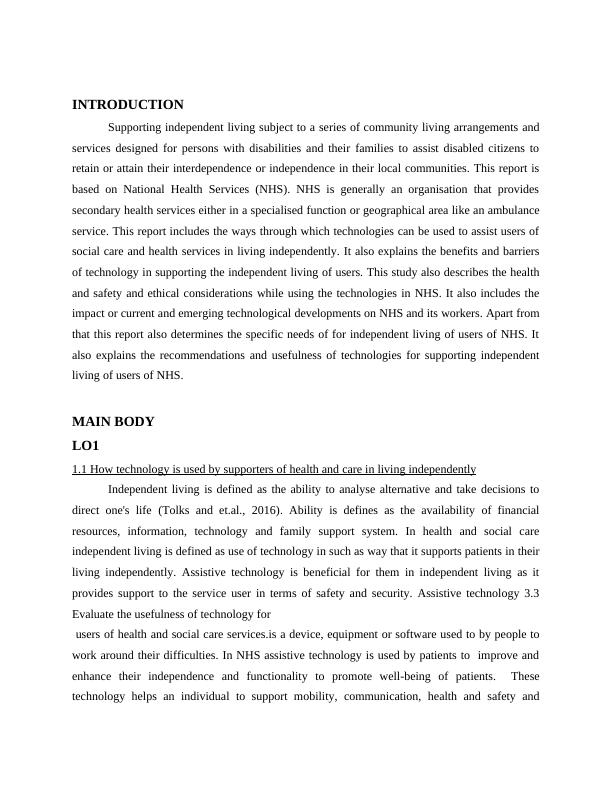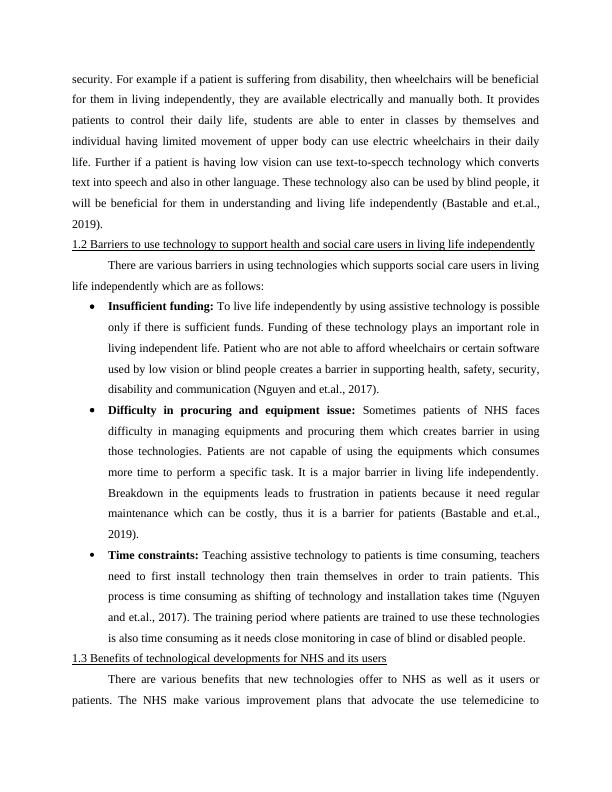Supporting Independent Living with Technology in NHS
Added on 2023-01-19
14 Pages4144 Words66 Views
Supporting Independent
Living
Living

Table of Contents
INTRODUCTION...........................................................................................................................3
MAIN BODY...................................................................................................................................3
LO1..................................................................................................................................................3
1.1 How technology is used by supporters of health and care in living independently...............3
1.2 Barriers to use technology to support health and social care users in living life
independently...............................................................................................................................4
1.3 Benefits of technological developments for NHS and its users.............................................4
LO2..................................................................................................................................................5
2.1 Health and safety considerations for using technologies in NHS..........................................6
2.2 Ethical considerations for using technologies in NHS..........................................................6
2.3 Explain the impact of recent and emerging technological developments on health care
services , organization and care workers. ...................................................................................7
LO3..................................................................................................................................................8
3.1 Identifying the specifics needs of particular individual requiring support to live
independently...............................................................................................................................8
3.2 Recommendation regarding hoe the technology might support the independent living
arrangements................................................................................................................................9
3.3 Evaluating usefulness of technology for users of health as well as social care services.......9
CONCLUSION .............................................................................................................................11
REFERENCES..............................................................................................................................12
INTRODUCTION...........................................................................................................................3
MAIN BODY...................................................................................................................................3
LO1..................................................................................................................................................3
1.1 How technology is used by supporters of health and care in living independently...............3
1.2 Barriers to use technology to support health and social care users in living life
independently...............................................................................................................................4
1.3 Benefits of technological developments for NHS and its users.............................................4
LO2..................................................................................................................................................5
2.1 Health and safety considerations for using technologies in NHS..........................................6
2.2 Ethical considerations for using technologies in NHS..........................................................6
2.3 Explain the impact of recent and emerging technological developments on health care
services , organization and care workers. ...................................................................................7
LO3..................................................................................................................................................8
3.1 Identifying the specifics needs of particular individual requiring support to live
independently...............................................................................................................................8
3.2 Recommendation regarding hoe the technology might support the independent living
arrangements................................................................................................................................9
3.3 Evaluating usefulness of technology for users of health as well as social care services.......9
CONCLUSION .............................................................................................................................11
REFERENCES..............................................................................................................................12

INTRODUCTION
Supporting independent living subject to a series of community living arrangements and
services designed for persons with disabilities and their families to assist disabled citizens to
retain or attain their interdependence or independence in their local communities. This report is
based on National Health Services (NHS). NHS is generally an organisation that provides
secondary health services either in a specialised function or geographical area like an ambulance
service. This report includes the ways through which technologies can be used to assist users of
social care and health services in living independently. It also explains the benefits and barriers
of technology in supporting the independent living of users. This study also describes the health
and safety and ethical considerations while using the technologies in NHS. It also includes the
impact or current and emerging technological developments on NHS and its workers. Apart from
that this report also determines the specific needs of for independent living of users of NHS. It
also explains the recommendations and usefulness of technologies for supporting independent
living of users of NHS.
MAIN BODY
LO1
1.1 How technology is used by supporters of health and care in living independently
Independent living is defined as the ability to analyse alternative and take decisions to
direct one's life (Tolks and et.al., 2016). Ability is defines as the availability of financial
resources, information, technology and family support system. In health and social care
independent living is defined as use of technology in such as way that it supports patients in their
living independently. Assistive technology is beneficial for them in independent living as it
provides support to the service user in terms of safety and security. Assistive technology 3.3
Evaluate the usefulness of technology for
users of health and social care services.is a device, equipment or software used to by people to
work around their difficulties. In NHS assistive technology is used by patients to improve and
enhance their independence and functionality to promote well-being of patients. These
technology helps an individual to support mobility, communication, health and safety and
Supporting independent living subject to a series of community living arrangements and
services designed for persons with disabilities and their families to assist disabled citizens to
retain or attain their interdependence or independence in their local communities. This report is
based on National Health Services (NHS). NHS is generally an organisation that provides
secondary health services either in a specialised function or geographical area like an ambulance
service. This report includes the ways through which technologies can be used to assist users of
social care and health services in living independently. It also explains the benefits and barriers
of technology in supporting the independent living of users. This study also describes the health
and safety and ethical considerations while using the technologies in NHS. It also includes the
impact or current and emerging technological developments on NHS and its workers. Apart from
that this report also determines the specific needs of for independent living of users of NHS. It
also explains the recommendations and usefulness of technologies for supporting independent
living of users of NHS.
MAIN BODY
LO1
1.1 How technology is used by supporters of health and care in living independently
Independent living is defined as the ability to analyse alternative and take decisions to
direct one's life (Tolks and et.al., 2016). Ability is defines as the availability of financial
resources, information, technology and family support system. In health and social care
independent living is defined as use of technology in such as way that it supports patients in their
living independently. Assistive technology is beneficial for them in independent living as it
provides support to the service user in terms of safety and security. Assistive technology 3.3
Evaluate the usefulness of technology for
users of health and social care services.is a device, equipment or software used to by people to
work around their difficulties. In NHS assistive technology is used by patients to improve and
enhance their independence and functionality to promote well-being of patients. These
technology helps an individual to support mobility, communication, health and safety and

security. For example if a patient is suffering from disability, then wheelchairs will be beneficial
for them in living independently, they are available electrically and manually both. It provides
patients to control their daily life, students are able to enter in classes by themselves and
individual having limited movement of upper body can use electric wheelchairs in their daily
life. Further if a patient is having low vision can use text-to-specch technology which converts
text into speech and also in other language. These technology also can be used by blind people, it
will be beneficial for them in understanding and living life independently (Bastable and et.al.,
2019).
1.2 Barriers to use technology to support health and social care users in living life independently
There are various barriers in using technologies which supports social care users in living
life independently which are as follows:
Insufficient funding: To live life independently by using assistive technology is possible
only if there is sufficient funds. Funding of these technology plays an important role in
living independent life. Patient who are not able to afford wheelchairs or certain software
used by low vision or blind people creates a barrier in supporting health, safety, security,
disability and communication (Nguyen and et.al., 2017).
Difficulty in procuring and equipment issue: Sometimes patients of NHS faces
difficulty in managing equipments and procuring them which creates barrier in using
those technologies. Patients are not capable of using the equipments which consumes
more time to perform a specific task. It is a major barrier in living life independently.
Breakdown in the equipments leads to frustration in patients because it need regular
maintenance which can be costly, thus it is a barrier for patients (Bastable and et.al.,
2019).
Time constraints: Teaching assistive technology to patients is time consuming, teachers
need to first install technology then train themselves in order to train patients. This
process is time consuming as shifting of technology and installation takes time (Nguyen
and et.al., 2017). The training period where patients are trained to use these technologies
is also time consuming as it needs close monitoring in case of blind or disabled people.
1.3 Benefits of technological developments for NHS and its users
There are various benefits that new technologies offer to NHS as well as it users or
patients. The NHS make various improvement plans that advocate the use telemedicine to
for them in living independently, they are available electrically and manually both. It provides
patients to control their daily life, students are able to enter in classes by themselves and
individual having limited movement of upper body can use electric wheelchairs in their daily
life. Further if a patient is having low vision can use text-to-specch technology which converts
text into speech and also in other language. These technology also can be used by blind people, it
will be beneficial for them in understanding and living life independently (Bastable and et.al.,
2019).
1.2 Barriers to use technology to support health and social care users in living life independently
There are various barriers in using technologies which supports social care users in living
life independently which are as follows:
Insufficient funding: To live life independently by using assistive technology is possible
only if there is sufficient funds. Funding of these technology plays an important role in
living independent life. Patient who are not able to afford wheelchairs or certain software
used by low vision or blind people creates a barrier in supporting health, safety, security,
disability and communication (Nguyen and et.al., 2017).
Difficulty in procuring and equipment issue: Sometimes patients of NHS faces
difficulty in managing equipments and procuring them which creates barrier in using
those technologies. Patients are not capable of using the equipments which consumes
more time to perform a specific task. It is a major barrier in living life independently.
Breakdown in the equipments leads to frustration in patients because it need regular
maintenance which can be costly, thus it is a barrier for patients (Bastable and et.al.,
2019).
Time constraints: Teaching assistive technology to patients is time consuming, teachers
need to first install technology then train themselves in order to train patients. This
process is time consuming as shifting of technology and installation takes time (Nguyen
and et.al., 2017). The training period where patients are trained to use these technologies
is also time consuming as it needs close monitoring in case of blind or disabled people.
1.3 Benefits of technological developments for NHS and its users
There are various benefits that new technologies offer to NHS as well as it users or
patients. The NHS make various improvement plans that advocate the use telemedicine to

End of preview
Want to access all the pages? Upload your documents or become a member.
Related Documents
Using Technology in NHS Supporting Independent Living INTRODUCTION 3 MAIN BODY3lg...
|13
|3851
|190
Supporting independent living in the context of health and social care technologieslg...
|12
|4095
|103
Supporting Independent Living in Health and Social Carelg...
|13
|4744
|41
Supporting Independent Living (doc)lg...
|11
|3772
|394
Supporting Independent Living | Assignmentlg...
|12
|4252
|37
Advances in Assistive Technology for Health and Social Carelg...
|16
|5647
|145
